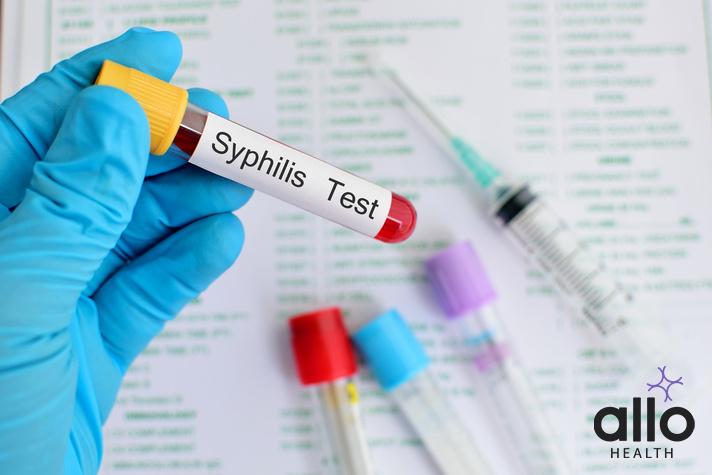Understanding Latent Syphilis: Causes, Symptoms, and Treatment

Allo Health is dedicated to personalized well-being, offering support and trusted information tailored to individual health goals. The platform emphasizes human-generated content, led by a distinguished medical team of experts, including physicians and sexual health specialists. Their commitment to credibility involves rigorous fact-checking, authoritative research, and continuous updates to ensure accurate, up-to-date information. Allo Health's unique approach goes beyond conventional platforms, providing expert-led insights and a continuous commitment to excellence, with user feedback playing a crucial role in shaping the platform's authoritative voice.

Dr Sanina Mansoor holds MBBS degree from Yenepoya university,Mangalore.She has 8 years of experience working as a medical officer at various health centres and medical colleges.
Why This Was Upated?
Our experts continually monitor the health and wellness space, and we update our articles when new information became available.
Updated on 20 May, 2024
- Article was updated as part of our commitment to diversity, equity, and inclusion.

"The following blog article provides general information and insights on various topics. However, it is important to note that the information presented is not intended as professional advice in any specific field or area. The content of this blog is for general educational and informational purposes only.
Book consultation
The content should not be interpreted as endorsement, recommendation, or guarantee of any product, service, or information mentioned. Readers are solely responsible for the decisions and actions they take based on the information provided in this blog. It is essential to exercise individual judgment, critical thinking, and personal responsibility when applying or implementing any information or suggestions discussed in the blog."
Here is your guide on latent syphilis, an essential resource delving into the causes, symptoms, available treatment options, and more. Acknowledging the sensitivity surrounding sexually transmitted diseases, we recognize the importance of fostering understanding to safeguard ourselves and our loved ones. In this article, we aim to provide a thorough exploration of latent syphilis, aiming to dispel discomfort through knowledge and promote informed decision-making in matters of sexual health.
What Is Latent Syphilis?
Latent syphilis is a stage of syphilis, a sexually transmitted infection (STI) caused by the bacterium Treponema pallidum. Syphilis progresses through several stages, and latent syphilis is one of them. The disease can be broadly categorized into primary, secondary, latent, and tertiary stages.
- Primary Syphilis:
- This is the initial stage when a person is first infected.
- The characteristic symptom is the appearance of a painless sore or ulcer known as a chancre at the site of infection (usually genital, anal, or oral).
- The chancre typically heals on its own within a few weeks.
- Secondary Syphilis:
- If left untreated, syphilis progresses to the secondary stage.
- This stage is marked by the development of a rash, mucous membrane lesions, and flu-like symptoms.
- Secondary syphilis can last for a few weeks to several months.
- Latent Syphilis:
- Latent syphilis is divided into two subcategories: early latent and late latent.
- Early latent syphilis occurs within the first year after initial infection, while late latent syphilis occurs more than one year after the initial infection.
- During latent syphilis, there are no visible symptoms, but the infection persists in the body.
- While the symptoms are not apparent, the infection can still be detected through blood tests.
- Tertiary Syphilis:
- Tertiary syphilis is the most severe stage and can occur years after the initial infection.
- It can lead to serious complications such as damage to the heart, brain, nerves, bones, and other organs.
- Tertiary syphilis is less common due to the availability of effective antibiotic treatment.
Syphilis can be effectively treated with antibiotics, especially in the early stages. Penicillin is the preferred antibiotic for syphilis treatment. Regular screenings, safe sexual practices, and early detection are crucial in preventing the progression of syphilis to more advanced stages. If you suspect you may have syphilis or any other STI, it is important to seek medical attention promptly for proper diagnosis and treatment.
Latent Syphilis Diagnosis
Diagnosing latent syphilis involves a combination of medical history, physical examinations, and laboratory tests. Since latent syphilis is characterized by the absence of visible symptoms, detection relies on serologic tests that can identify the presence of antibodies produced in response to the infection. Here is a detailed overview of the diagnostic process for latent syphilis:
- Medical History and Physical Examination:
- Healthcare providers will conduct a thorough medical history, including questions about sexual activity, previous STIs, and potential exposure to syphilis.
- A physical examination may be performed to check for any visible signs of syphilis, even though they are absent in the latent stage.
- Serologic Tests:
- Serologic tests are the primary diagnostic tools for latent syphilis.
- Rapid Plasma Reagin (RPR) Test: This blood test detects antibodies produced in response to syphilis infection. It provides a quick result, but false positives can occur.
- Venereal Disease Research Laboratory (VDRL) Test: Similar to the RPR test, the VDRL test measures the presence of antibodies. Both tests are commonly used for screening.
- Treponemal Tests:
- Fluorescent Treponemal Antibody Absorption (FTA-ABS) Test: This confirms the presence of antibodies to the syphilis bacterium.
- Treponema pallidum Particle Agglutination (TP-PA) Test: A specific and confirmatory test for syphilis antibodies.
- Testing for Other STIs: Since individuals with syphilis may be at risk for other STIs, healthcare providers may recommend additional tests for infections such as HIV, gonorrhea, and chlamydia.
- Cerebrospinal Fluid Examination (CSF): In cases of suspected neurosyphilis (involving the nervous system), a lumbar puncture may be performed to examine the cerebrospinal fluid for signs of infection.
- Pregnancy Testing: Pregnant individuals are routinely tested for syphilis during prenatal care to prevent congenital syphilis. Positive results may prompt further testing and treatment.

Serologic tests alone cannot distinguish between current and past infections or differentiate between early and late latent syphilis. Clinical judgment, in conjunction with the results of these tests, helps healthcare providers make an accurate diagnosis. Prompt diagnosis and treatment are critical to preventing the progression of syphilis and reducing the risk of complications. Individuals at risk of syphilis should undergo regular screenings and seek medical attention if they suspect exposure or experience any symptoms.
Latent Syphilis Symptoms
Latent syphilis is a stage of the infection where there are no visible symptoms, and the person may not be aware of the presence of the bacterium Treponema pallidum in their body. The absence of symptoms during latent syphilis can make it challenging for individuals to realize they are infected. However, even in the absence of apparent symptoms, the infection can still be detected through blood tests. Latent syphilis is further classified into early latent and late latent stages.
- Early Latent Syphilis:
- This stage occurs within the first year after the initial infection.
- Despite the lack of visible symptoms, the bacterium is actively present in the body.
- Regular blood tests, such as the rapid plasma reagin (RPR) or venereal disease research laboratory (VDRL) test, can detect the infection during this stage.
- Late Latent Syphilis:
- Late latent syphilis occurs more than one year after the initial infection.
- As with early latent syphilis, there are no apparent symptoms.
- Blood tests remain the primary method for detecting the infection.
While latent syphilis itself does not cause symptoms, if the infection progresses to the tertiary stage, severe complications can arise, affecting various organs and systems in the body. These complications can include cardiovascular concerns, neurosyphilis (involving the nervous system), and gummatous syphilis (resulting in the formation of destructive lesions).
Regular screenings and prompt treatment during the early stages of syphilis are crucial for preventing the progression of the infection and reducing the risk of complications. Since latent syphilis does not present visible symptoms, individuals at risk of syphilis, such as those with multiple sexual partners or engaging in unprotected sex, should undergo routine STI screenings to detect and treat the infection early on. If you suspect you may have syphilis or any other STI, it is essential to consult with a healthcare professional for appropriate testing, diagnosis, and treatment.
Types Of Lesions In Latent Syphilis
In latent syphilis, there are typically no visible lesions or sores, as this stage is characterized by the absence of symptoms. However, it’s important to understand the types of lesions that may have occurred in the earlier stages of syphilis (primary and secondary stages) before the infection entered the latent phase. Lesions in syphilis are manifestations of the bacterium Treponema pallidum and can vary during different stages of the infection. Here’s an overview of lesions in the earlier stages:
- Primary Syphilis Lesions:
- Chancre: The primary lesion of syphilis is a painless, firm, and round sore called a chancre. It typically appears at the site of infection, such as the genital, anal, or oral areas. Chancres are usually solitary and may go unnoticed due to their painlessness. They heal spontaneously within a few weeks, even without treatment.
- Secondary Syphilis Lesions:
- Skin Rash: As syphilis progresses to the secondary stage, a wide-ranging rash may develop on various parts of the body. This rash is often characterized by small, red, and rough spots. It may involve the palms of the hands and soles of the feet.
- Mucous Membrane Lesions: Flat, moist, wart-like growths, known as condylomata lata, can appear in warm and moist areas, such as the genital, anal, and oral regions. These lesions are highly contagious and can contribute to the spread of the infection.
- Latent Syphilis:
- As the infection enters the latent stage, the visible symptoms, including lesions, disappear. Latent syphilis is characterized by the absence of clinical manifestations. However, the bacterium remains in the body, and the infection can be detected through serologic tests.
It’s crucial to note that latent syphilis does not present visible lesions, making it challenging for individuals to self-diagnose during this stage. The progression from primary and secondary lesions to the latent phase underscores the importance of early detection and treatment to prevent the development of tertiary syphilis and associated complications. Regular screenings and prompt medical attention are vital in managing and treating syphilis effectively. If there is a concern about potential syphilis exposure or symptoms, individuals should consult with healthcare professionals for appropriate testing and guidance.
Latent Syphilis Causes
Latent syphilis is caused by the bacterium Treponema pallidum, which is responsible for the sexually transmitted infection known as syphilis. Syphilis is primarily transmitted through direct contact with syphilis sores, also called chancres, that occur during the primary stage of the infection. The bacterium can enter the body through mucous membranes or breaks in the skin, typically during sexual activity.
- Transmission:
- The primary mode of syphilis transmission is through sexual contact, including vaginal, anal, and oral sex.
- The infection can be transmitted from an infected person to their sexual partner(s) through contact with syphilis sores or mucous membrane lesions.
- Vertical Transmission:
- Pregnant women with syphilis can transmit the infection to their unborn child during pregnancy or childbirth. This is known as vertical transmission.
- Syphilis in pregnancy can lead to congenital syphilis, which can have severe consequences for the newborn, including developmental concerns, organ damage, and even death.
- Blood Transmission:
- Although less common, syphilis can also be transmitted through blood transfusions or organ transplants if the donor is infected.
- Sharing needles or syringes with an infected person can also result in the transmission of syphilis.
- Other Modes of Transmission:
- While rare, syphilis can be transmitted through nonsexual contact if there is direct contact with syphilis sores or lesions.
- Syphilis is not spread through casual contact such as hugging, kissing, or sharing utensils.
- Increased Risk Factors:
- Individuals engaging in unprotected sexual activity, having multiple sexual partners, or having sexual contact with someone diagnosed with syphilis are at an increased risk of acquiring the infection.
- Lack of consistent and correct condom use during sexual activity can contribute to the spread of syphilis.
Bacterium Treponema pallidum can lead to various stages of syphilis, including primary, secondary, latent, and tertiary stages. Latent syphilis is characterized by the absence of visible symptoms, making it challenging for individuals to detect the infection without specific testing. Early diagnosis through regular screenings and prompt treatment with antibiotics are crucial to prevent the progression of syphilis and reduce the risk of complications. Individuals at risk of syphilis should consult with healthcare professionals for appropriate testing and preventive measures.

Latent Syphilis Complications
Latent syphilis itself does not cause immediate complications, as this stage is characterized by the absence of visible symptoms. However, if left untreated, syphilis can progress to the tertiary stage, which is associated with severe complications. Here’s an overview of potential complications associated with latent syphilis and its progression:
- Tertiary Syphilis:
- Cardiovascular Syphilis: This complication involves the inflammation of blood vessels and can lead to aortic aneurysms or heart valve damage. Cardiovascular syphilis can have serious implications for the circulatory system.
- Neurosyphilis: The bacterium can invade the central nervous system, causing neurosyphilis. This condition may lead to various neurological symptoms, including headache, confusion, visual concerns, and, in severe cases, paralysis.
- Gummatous Syphilis: Tertiary syphilis may result in the formation of soft, non-cancerous growths called gummas. These lesions can develop in various organs, including the skin, bones, liver, and other tissues, causing damage and deformities.
- Ocular Syphilis: Syphilis can affect the eyes, leading to ocular syphilis. This condition may cause inflammation of the eyes, vision changes, and even permanent vision loss if left untreated.
- Congenital Syphilis: If a pregnant woman with latent syphilis does not receive adequate treatment, the infection can be transmitted to the unborn child, leading to congenital syphilis. This can result in serious health concerns for the newborn, including developmental concerns, organ damage, and, in severe cases, stillbirth.
- Increased Risk of HIV Transmission: Having syphilis, including latent syphilis, may increase the risk of acquiring or transmitting HIV. The open sores and ulcers associated with primary and secondary syphilis can provide entry points for the HIV virus.
- General Health Impacts: Untreated syphilis can have a detrimental impact on overall health, affecting various organs and systems. The complications can lead to chronic health conditions, reduced quality of life, and, in some cases, life-threatening situations.
It’s crucial to emphasize the significance of early detection and treatment to prevent the progression of syphilis to tertiary stages and reduce the risk of complications. Regular screenings, prompt medical attention, and partner notification are essential components of syphilis management. Individuals who suspect exposure to syphilis or experience symptoms should seek timely medical care for appropriate testing, diagnosis, and treatment.
Latent Syphilis Treatment
Latent syphilis is typically treated with antibiotics, and the choice of antibiotic depends on the stage of latent syphilis, whether it is early or late latent syphilis. The primary goal of treatment is to eliminate the bacterium Treponema pallidum from the body and prevent the progression of the infection to more severe stages or complications. Penicillin is the preferred antibiotic for treating syphilis, and the specific regimen depends on the stage of the infection.
- Early Latent Syphilis Treatment:
- For early latent syphilis (within the first year after initial infection), a single intramuscular injection of benzathine penicillin G is the standard treatment.
- Alternative antibiotics, such as doxycycline or tetracycline, may be used for individuals who are allergic to penicillin.
- Late Latent Syphilis Treatment:
- Late latent syphilis (more than one year after initial infection) requires a longer course of treatment.
- The standard treatment involves three weekly intramuscular injections of benzathine penicillin G.
- Alternative antibiotics, such as doxycycline or tetracycline, may be used for individuals allergic to penicillin.
Please note the following considerations:
- Pregnant Women:
- Pregnant women diagnosed with latent syphilis should receive penicillin treatment, as it is safe and effective.
- The type and duration of treatment may be adjusted based on the stage of syphilis and individual circumstances.
- Follow-Up Testing:
- After treatment, individuals with latent syphilis should undergo follow-up testing to ensure the infection has been successfully treated.
- Serologic tests, such as the rapid plasma reagin (RPR) or venereal disease research laboratory (VDRL) test, are commonly used to monitor treatment response.
- Preventing Transmission:
- It’s crucial for individuals undergoing treatment to abstain from sexual activity until the treatment is complete, and the infection is no longer detectable.
- Sexual partners should also be notified, tested, and treated if necessary.
- Partner Notification and Testing: Individuals diagnosed with syphilis, including latent syphilis, should inform their sexual partners so that they can be tested and treated if necessary.
- Resistant Cases: While resistance to penicillin in treating syphilis is rare, healthcare providers may consider alternative antibiotics for cases of documented penicillin allergy or when other considerations warrant a different approach.
It’s essential for individuals diagnosed with latent syphilis to follow their healthcare provider’s recommendations closely, complete the prescribed course of antibiotics, and attend follow-up appointments to ensure successful treatment and prevent complications. Prompt and effective treatment is crucial in preventing the progression of syphilis to more advanced stages and reducing the risk of long-term health complications.
Latent Syphilis Prevention
Preventing latent syphilis involves strategies aimed at avoiding the initial infection, as well as identifying and treating the infection in its early stages to prevent progression. Here are detailed measures for preventing latent syphilis:
- Safe Sexual Practices:
- Consistent Condom Use: Correct and consistent use of latex or polyurethane condoms during vaginal, anal, and oral sex can reduce the risk of syphilis transmission.
- Limiting Sexual Partners: Reducing the number of sexual partners can lower the risk of exposure to syphilis and other sexually transmitted infections (STIs).
- Regular Testing and Screening:
- Sexually Active Individuals: Individuals who are sexually active, especially those with multiple sexual partners, should undergo regular STI screenings, including tests for syphilis.
- Pregnant Women: Routine syphilis testing is a standard part of prenatal care to detect and treat the infection in pregnant women and prevent congenital syphilis.
- Partner Notification and Testing:
- If an individual is diagnosed with syphilis, it is crucial to notify and encourage testing for sexual partners. This helps in identifying and treating potential cases early.
- Prompt treatment of infected individuals reduces the risk of progression to latent syphilis and the potential for complications.
- Pre-Exposure Prophylaxis (PrEP): PrEP is a preventive approach for individuals at high risk of acquiring HIV, but it does not protect against syphilis or other STIs. Those considering PrEP should discuss their overall risk and prevention strategies with healthcare providers.
- Avoiding Risky Behaviors:
- Avoiding sharing needles or drug paraphernalia can prevent the transmission of syphilis and other blood-borne infections.
- Engaging in non-penetrative sexual activities or choosing lower-risk sexual practices can reduce the likelihood of infection.
- Education and Awareness:
- Educating individuals about the risks of syphilis, its modes of transmission, and the importance of early detection and treatment is essential.
- Increasing awareness about syphilis within communities and healthcare settings can contribute to prevention efforts.
- Prompt Treatment:
- Early detection and treatment of syphilis during the primary and secondary stages can prevent the progression to latent syphilis and reduce the risk of complications.
- Timely treatment with antibiotics, especially with penicillin, is crucial for eliminating the bacterium and preventing further transmission.
Syphilis prevention is a multifaceted approach involving individual responsibility, regular healthcare check-ups, and public health interventions. Individuals at risk should actively participate in preventive measures, and healthcare providers play a key role in education, testing, and treatment. Regular communication and collaboration between individuals, healthcare professionals, and public health organizations are essential components of an effective syphilis prevention strategy.
Most Asked Questions
-
What is latent syphilis, and how does it differ from other stages of the infection?
Latent syphilis is a stage of syphilis characterized by the absence of visible symptoms. It follows the primary and secondary stages and can be categorized into early latent (within the first year) and late latent (more than one year) phases. Unlike primary and secondary syphilis, where symptoms like sores and rashes are present, latent syphilis does not manifest noticeable signs.
-
How is latent syphilis diagnosed, considering the absence of visible symptoms?
Diagnosis of latent syphilis is primarily through blood tests, such as the rapid plasma reagin (RPR) or venereal disease research laboratory (VDRL) test. These tests detect antibodies produced in response to the infection. Regular screenings are essential for early detection, especially in individuals at risk of syphilis.
-
What are the consequences if latent syphilis is left untreated?
If untreated, latent syphilis can progress to tertiary syphilis, leading to severe complications such as damage to the heart, brain, nerves, and other organs. Tertiary syphilis is less common due to the availability of effective antibiotic treatment. Timely intervention is crucial to prevent these long-term health concerns.
-
Can latent syphilis be transmitted to others, even without visible symptoms?
Yes, latent syphilis can still be transmitted to sexual partners, even in the absence of visible symptoms. It underscores the importance of regular testing, partner notification, and safe sexual practices to prevent the spread of the infection.
-
What is the recommended treatment for latent syphilis, and does it differ based on the stage?
The preferred treatment for latent syphilis is penicillin. For early latent syphilis, a single intramuscular injection of benzathine penicillin G is often sufficient. Late latent syphilis may require three weekly injections. Alternative antibiotics may be considered for those allergic to penicillin. Treatment is crucial to eliminate the bacterium and prevent complications.






































